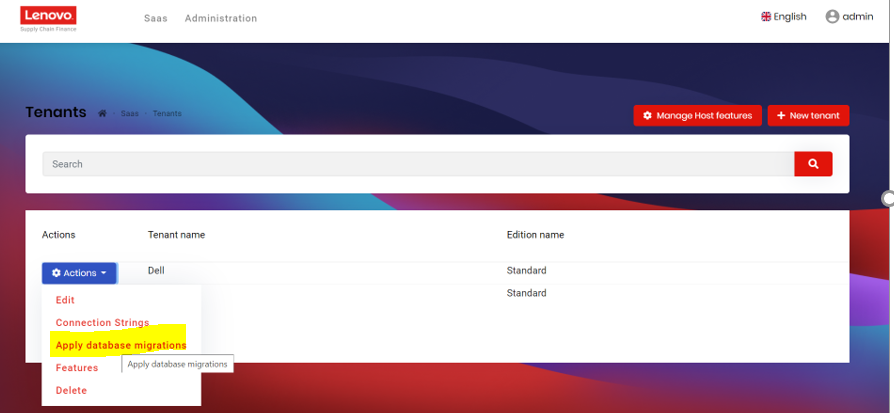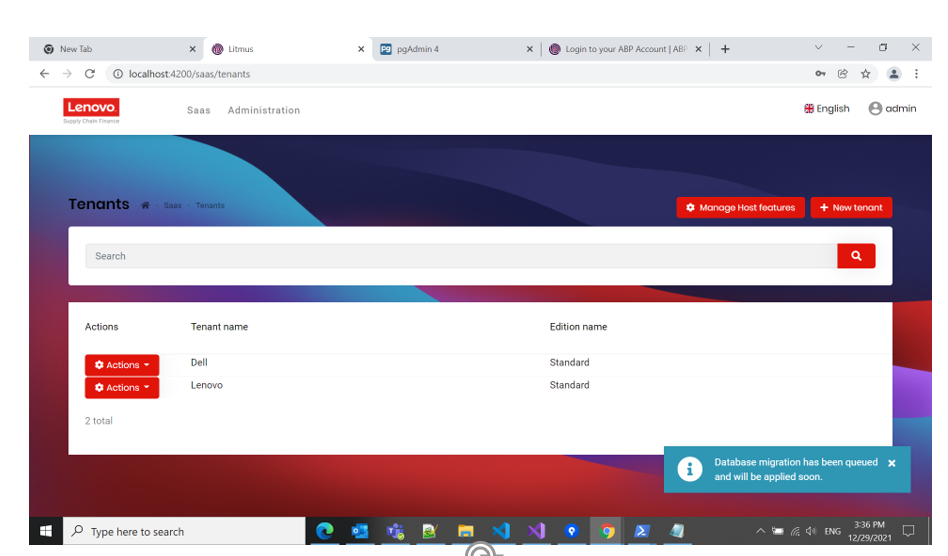Activities of "vishalnikam"
- ABP Framework version: v4.3.1
- UI type: Angular
- DB provider: EF Core / PostgreSQL
- Tiered (MVC) or Identity Server Separated (Angular): yes
- Exception message and stack trace:
- Steps to reproduce the issue:"
We already have one tenant with silo database approach. now, wanted to add new tenant as same. added one tenant and database string (empty database). clicked on apply migration link. it says database migration has been queued and will be applied soon. then nothing happen to database. where do we check the queued entry and status in db.
please guide on new tenant add process. also database migration is automatic process or manual ? when we have more then two tenant then new table migration will be applied to both tenant or what ? how specify apply for particular tenant ?
- ABP Framework version: v4.3.1
- UI type: Angular
- DB provider: EF Core
- Tiered (MVC) or Identity Server Separated (Angular): yes
- Exception message and stack trace:
- Steps to reproduce the issue:"
We are using Reference type ("AccessTokenType" = 1) and token time set to 1200 (20 min) for "IdentityTokenLifetime" and "AccessTokenLifetime" in "IdentityServerClients" user is getting logout for keeping screen idle for 10min and Angular hits api/abp/application-configuration API. how this session timeout can be increased to 20 min?
- ABP Framework version: v4.3.1
- UI type: Angular
- DB provider: EF Core
- Tiered (MVC) or Identity Server Separated (Angular): yes
- Exception message and stack trace:
- Steps to reproduce the issue:"
When we login into to ABP application token is generated with "Password" grant type. can we use other grant type for login as password grant type, which is discouraged by Oauth2.0 security best practices. ? where can we change this and will new token work with user permissions ?
- ABP Framework version: v4.3.1
- UI type: Angular
- DB provider: EF Core
- Tiered (MVC) or Identity Server Separated (Angular): yes
- Exception message and stack trace:
- Steps to reproduce the issue:"
There is requirment that as ABP platform admin, he should be able to get the details of all the tenant admin. Our understanding is that need to create custom screen to display below data but please help us how we can get this through services on ABP platform as we have seperate DB's for tenant management and need below details
- Role Name
- Owner Name(First + Last Name)
- Last Login
- Dormant Account Status(Logic configurable e.g user not logged in for >45 days)
- Active Status(Deleted Flag = N)
- ABP Framework version: v3.0.4
- UI type: Angular
- DB provider: EF Core
- Tiered (MVC) or Identity Server Separated (Angular): yes
- Exception message and stack trace:
- Steps to reproduce the issue:
We have AWS hosting and the SingleR AbpHub is hosted in multiple ECS containers. The SignalR Redis backplane uses the pub/sub feature to forward messages to other servers. could you please help on how to enble radis backplane in ABP SignalR.
- ABP Framework version: v3.0.4
- UI type: Angular
- DB provider: EF Core
- Tiered (MVC) or Identity Server Separated (Angular): yes
- Exception message and stack trace:
- Steps to reproduce the issue:
We have multitenancy application, if we add Roles to main admin those are not reflecting or displayed under Teant admin.
Please latest know how all roles of main ABP admin should be displayed across all Teanat admin.
- ABP Framework version: v3.0.4
- UI type: Angular
- DB provider: EF Core
- Tiered (MVC) or Identity Server Separated (Angular): yes
- Exception message and stack trace:
- Steps to reproduce the issue:
Could you please help us on below queries related to access token
- How to prevent user from logging in multiple times and creating multiple simultaneous sessions.
- How to set session or token timeout in ABP framework? how it is handel this, if user is idel for some time and should be logged out.
- Currently, JSON web token (JWT) is not encrypted and can revealed the email (username) and expiration date of the token. how to encrypt it or is there any configuration settings.
- ABP Framework version: v3.0.4
- UI type: Angular
- DB provider: EF Core
- Tiered (MVC) or Identity Server Separated (Angular): yes
- Exception message and stack trace:
- Steps to reproduce the issue:
is Identity management module / access control support approval flow and notification or how to achieve this?
- If user changed his email then it should be approved by admin. or any way to block user from changing his email address in profile.
- user should get the notification on role changed.
- auto revoke access on particular event or after time period.
- How to deactivate user and not delete.
- ABP Framework version: v3.0.4
- UI type: Angular
- DB provider: EF Core
- Tiered (MVC) or Identity Server Separated (Angular): yes
- Exception message and stack trace:
- Steps to reproduce the issue:
We have created one role called i.e. SupplierAdmin and have below sample policies
Supplier Supplier.Create Supplier.Edit Supplier.Delete Supplier.View
Kindly let me know on below queries
- If there any feature/setting to trigger notification we user role get changed
- How to map ABP user/create user to supplier entity in ABP user creation screen, so that when he login to system, he should be able to see same supplier info.
- How to set different permissions for 2 users, having same role.
- How to automatically revoke one permission if other user is assigned same permission e.g. one user assigned Supplier.Create then other user with same permission should be revoked automatically.
Check the docs before asking a question: https://docs.abp.io/en/commercial/latest/ Check the samples, to see the basic tasks: https://docs.abp.io/en/commercial/latest/samples/index The exact solution to your question may have been answered before, please use the search on the homepage.
- ABP Framework version: v3.0.4
- UI type: Angular
- Tiered (MVC) or Identity Server Seperated (Angular): yes
- Exception message and stack trace:
- Steps to reproduce the issue:
Identity server with custom domain not working in AWS ECS and not validating token show below error
Exception - System.InvalidOperationException: IDX20803: Unable to obtain configuration from: '[PII is hidden. For more details, see https://aka.ms/IdentityModel/PII.]'.
---> System.IO.IOException: IDX20804: Unable to retrieve document from: '[PII is hidden. For more details, see https://aka.ms/IdentityModel/PII.]'.
---> System.Net.Http.HttpRequestException: Name or service not known
---> System.Net.Sockets.SocketException (0xFFFDFFFF): Name or service not known
at System.Net.Http.ConnectHelper.ConnectAsync(String host, Int32 port, CancellationToken cancellationToken)
--- End of inner exception stack trace ---
at System.Net.Http.ConnectHelper.ConnectAsync(String host, Int32 port, CancellationToken cancellationToken)
at System.Net.Http.HttpConnectionPool.ConnectAsync(HttpRequestMessage request, Boolean allowHttp2, CancellationToken cancellationToken)
at System.Net.Http.HttpConnectionPool.CreateHttp11ConnectionAsync(HttpRequestMessage request, CancellationToken cancellationToken)
at System.Net.Http.HttpConnectionPool.GetHttpConnectionAsync(HttpRequestMessage request, CancellationToken cancellationToken)
at System.Net.Http.HttpConnectionPool.SendWithRetryAsync(HttpRequestMessage request, Boolean doRequestAuth, CancellationToken cancellationToken)
at System.Net.Http.RedirectHandler.SendAsync(HttpRequestMessage request, CancellationToken cancellationToken)
at System.Net.Http.DiagnosticsHandler.SendAsync(HttpRequestMessage request, CancellationToken cancellationToken)
at System.Net.Http.HttpClient.FinishSendAsyncBuffered(Task1 sendTask, HttpRequestMessage request, CancellationTokenSource cts, Boolean disposeCts) at Microsoft.IdentityModel.Protocols.HttpDocumentRetriever.GetDocumentAsync(String address, CancellationToken cancel) --- End of inner exception stack trace --- at Microsoft.IdentityModel.Protocols.HttpDocumentRetriever.GetDocumentAsync(String address, CancellationToken cancel) at Microsoft.IdentityModel.Protocols.OpenIdConnect.OpenIdConnectConfigurationRetriever.GetAsync(String address, IDocumentRetriever retriever, CancellationToken cancel) at Microsoft.IdentityModel.Protocols.ConfigurationManager1.GetConfigurationAsync(CancellationToken cancel)
--- End of inner exception stack trace ---
at Microsoft.IdentityModel.Protocols.ConfigurationManager1.GetConfigurationAsync(CancellationToken cancel) at Microsoft.AspNetCore.Authentication.JwtBearer.JwtBearerHandler.HandleAuthenticateAsync() at Microsoft.AspNetCore.Authentication.JwtBearer.JwtBearerHandler.HandleAuthenticateAsync() at Microsoft.AspNetCore.Authentication.AuthenticationHandler1.AuthenticateAsync()
at Microsoft.AspNetCore.Authentication.AuthenticationService.AuthenticateAsync(HttpContext context, String scheme)
at IdentityServer4.AccessTokenValidation.IdentityServerAuthenticationHandler.HandleAuthenticateAsync()
Timestamp - 12/16/2020 12:01:13 +00:00 | Level - Error | Message IDX20803: Unable to obtain configuration from: '[PII is hidden. For more details, see https://aka.ms/IdentityModel/PII.]'. {"SourceContext":{"Value":"IdentityServer4.AccessTokenValidation.IdentityServerAuthenticationHandler"},"RequestId":{"Value":"0HM51N8VNE06N:00000001"},"RequestPath":{"Value":"/test/getSummary"},"SpanId":{"Value":"|f30d46a6-453bf21c21f8eb96."},"TraceId":{"Value":"f30d46a6-453bf21c21f8eb96"},"ParentId":{"Value":""},"ConnectionId":{"Value":"0HM51N8VNE06N"}} Exception - System.InvalidOperationException: IDX20803: Unable to obtain configuration from: '[PII is hidden. For more details, see https://aka.ms/IdentityModel/PII.]'. ---> System.IO.IOException: IDX20804: Unable to retrieve document from: '[PII is hidden. For more details, see https://aka.ms/IdentityModel/PII.]'. ---> System.Net.Http.HttpRequestException: Name or service not known ---> System.Net.Sockets.SocketException (0xFFFDFFFF): Name or service not known at System.Net.Http.ConnectHelper.ConnectAsync(String host, Int32 port, CancellationToken cancellationToken) --- End of inner exception stack trace --- at System.Net.Http.ConnectHelper.ConnectAsync(String host, Int32 port, CancellationToken cancellationToken) at System.Net.Http.HttpConnectionPool.ConnectAsync(HttpRequestMessage request, Boolean allowHttp2, CancellationToken cancellationToken) at System.Net.Http.HttpConnectionPool.CreateHttp11ConnectionAsync(HttpRequestMessage request, CancellationToken cancellationToken) at System.Net.Http.HttpConnectionPool.GetHttpConnectionAsync(HttpRequestMessage request, CancellationToken cancellationToken) at System.Net.Http.HttpConnectionPool.SendWithRetryAsync(HttpRequestMessage request, Boolean doRequestAuth, CancellationToken cancellationToken) at System.Net.Http.RedirectHandler.SendAsync(HttpRequestMessage request, CancellationToken cancellationToken) at System.Net.Http.DiagnosticsHandler.SendAsync(HttpRequestMessage request, CancellationToken cancellationToken) at System.Net.Http.HttpClient.FinishSendAsyncBuffered(Task1 sendTask, HttpRequestMessage request, CancellationTokenSource cts, Boolean disposeCts) at Microsoft.IdentityModel.Protocols.HttpDocumentRetriever.GetDocumentAsync(String address, CancellationToken cancel) --- End of inner exception stack trace --- at Microsoft.IdentityModel.Protocols.HttpDocumentRetriever.GetDocumentAsync(String address, CancellationToken cancel) at Microsoft.IdentityModel.Protocols.OpenIdConnect.OpenIdConnectConfigurationRetriever.GetAsync(String address, IDocumentRetriever retriever, CancellationToken cancel) at Microsoft.IdentityModel.Protocols.ConfigurationManager1.GetConfigurationAsync(CancellationToken cancel) --- End of inner exception stack trace --- at Microsoft.IdentityModel.Protocols.ConfigurationManager1.GetConfigurationAsync(CancellationToken cancel) at Microsoft.AspNetCore.Authentication.JwtBearer.JwtBearerHandler.HandleAuthenticateAsync() at Microsoft.AspNetCore.Authentication.JwtBearer.JwtBearerHandler.HandleAuthenticateAsync() at Microsoft.AspNetCore.Authentication.AuthenticationHandler1.AuthenticateAsync() at Microsoft.AspNetCore.Authentication.AuthenticationService.AuthenticateAsync(HttpContext context, String scheme) at IdentityServer4.AccessTokenValidation.IdentityServerAuthenticationHandler.HandleAuthenticateAsync()



